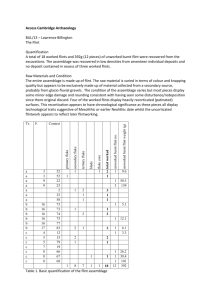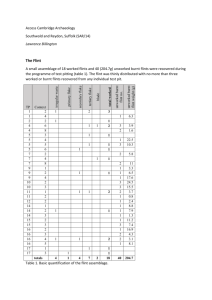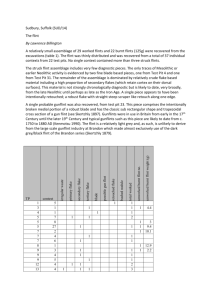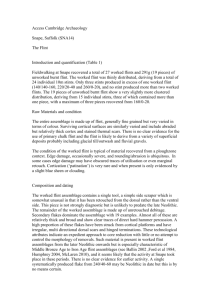Lawrence Billington 08/2015 Access Cambridge Archaeology
advertisement
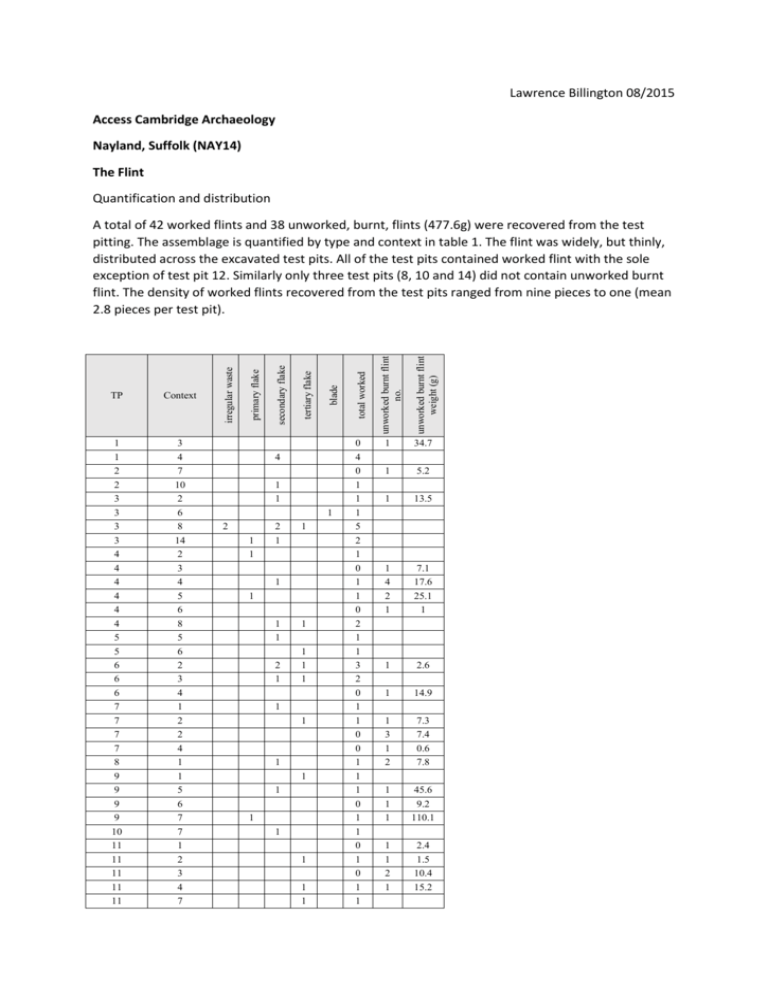
Lawrence Billington 08/2015 Access Cambridge Archaeology Nayland, Suffolk (NAY14) The Flint Quantification and distribution 4 1 1 1 2 1 1 2 1 1 1 1 1 1 2 1 1 1 1 1 1 1 1 1 1 1 1 1 1 1 0 4 0 1 1 1 5 2 1 0 1 1 0 2 1 1 3 2 0 1 1 0 0 1 1 1 0 1 1 0 1 0 1 1 unworked burnt flint weight (g) unworked burnt flint no. total worked blade 3 4 7 10 2 6 8 14 2 3 4 5 6 8 5 6 2 3 4 1 2 2 4 1 1 5 6 7 7 1 2 3 4 7 tertiary flake 1 1 2 2 3 3 3 3 4 4 4 4 4 4 5 5 6 6 6 7 7 7 7 8 9 9 9 9 10 11 11 11 11 11 secondary flake Context primary flake TP irregular waste A total of 42 worked flints and 38 unworked, burnt, flints (477.6g) were recovered from the test pitting. The assemblage is quantified by type and context in table 1. The flint was widely, but thinly, distributed across the excavated test pits. All of the test pits contained worked flint with the sole exception of test pit 12. Similarly only three test pits (8, 10 and 14) did not contain unworked burnt flint. The density of worked flints recovered from the test pits ranged from nine pieces to one (mean 2.8 pieces per test pit). 1 34.7 1 5.2 1 13.5 1 4 2 1 7.1 17.6 25.1 1 1 2.6 1 14.9 1 3 1 2 7.3 7.4 0.6 7.8 1 1 1 45.6 9.2 110.1 1 1 2 1 2.4 1.5 10.4 15.2 1 1 1 1 1 2 4 1 24 11 1 0 0 1 0 1 1 1 0 1 0 0 0 1 42 unworked burnt flint weight (g) unworked burnt flint no. total worked blade tertiary flake 9 5 9 10 10 11 12 3 4 4 5 9 7b Totals secondary flake 12 13 13 13 14 14 14 15 15 16 16 16 16 primary flake Context irregular waste TP 1 1 46 1 43 1 2 1 1 1 1 38 7.2 9.9 3.3 7.8 2.7 18.5 477.6 Table 1. Quantification of the flint assemblage by context and type. Raw Materials and condition The entire assemblage is made up of good quality fine grained flint, varied in colour but generally a dark grey/black. Surviving cortical surfaces suggest the use of relatively small nodules/cobbles deriving from fluvial or glacio-fluvial gravels. Such material is probably locally available in the river terrace gravel deposits that flank the Stour valley, or in the glacial outwash/fluvial gravels that outcrop further up the valley slopes and on the interfluves (Kesgrave gravels and Lowestoft formation). The condition of the assemblage is varied but generally pieces are in poor condition, with frequent edge damage and rounding consistent with extensive post depositional disturbance. Some pieces (notably from Test Pits 1, 3, 9 and 11) are very worn with heavily abraded glossy surfaces. In contrast some of the worked flint is in relatively fresh condition, these include most of the nine worked flints recovered from test pit 3 and individual examples from test pits 8 and 14. These pieces do not appear to have suffered much in the way of redeposition/disturbance and may relate more closely to locations of prehistoric activity than the remainder of the assemblage. Technology and dating The assemblage is made up exclusively of unretouched removals and there is a complete absence of cores or tools. This makes any assessment of the date of the assemblage difficult. There are very few pieces which show technological traits characteristic of ‘early’ (Mesolithic/earlier Neolithic) blade based technologies, which appear to be represented solely by the broken medial portion of a fine blade from test pit 3. The remainder of the assemblage is best described as representing a generalised and expedient flake based technology. Most removals are clearly hard hammer struck and there is a lack of platform preparation or evidence of core maintenance. Partly cortical flakes dominate the assemblage, suggesting either that the earlier stages of core reduction are over represented in the assemblage or that relatively few removals were made from individual cores before they were discarded. This material is not strongly chronologically diagnostic but is characteristic of later prehistoric flint working and it is likely that it relates largely to activity during the Early Bronze Age through to the Iron Age (c. 2300 – 500 BC). Discussion The assemblage from Nayland clearly indicates that evidence for later prehistoric activity is widely distributed across the site of the modern village. There is very little evidence of activity predating the Early Bronze Age but this is likely to be an artefact of the small size of the assemblage rather than indicating a genuine lack of activity during the Mesolithic and Neolithic. It is difficult to interpret the kind of activities that the flintwork represents but it certainly included the working of flint probably obtained from immediately local sources. Whether this was associated with any ‘domestic’ or settlement type activity is unclear from the present assemblage.
